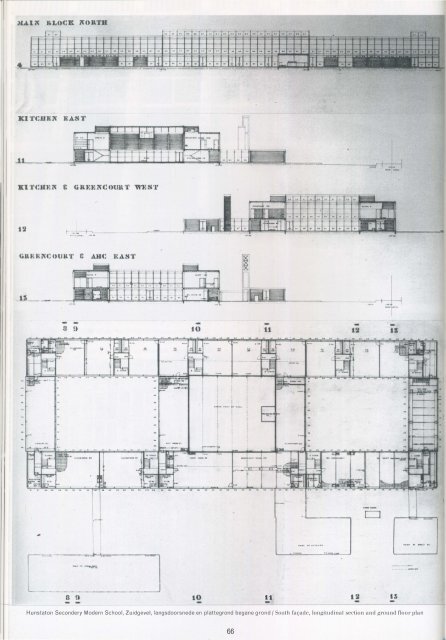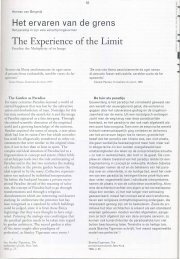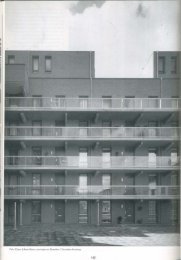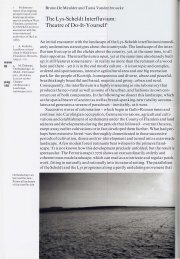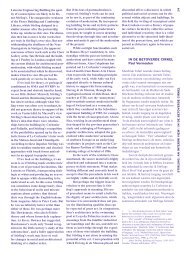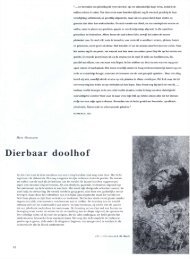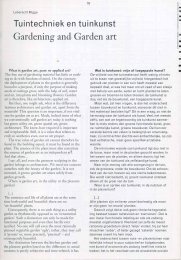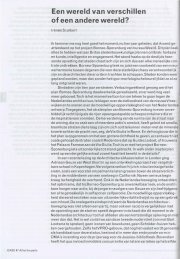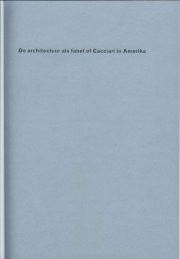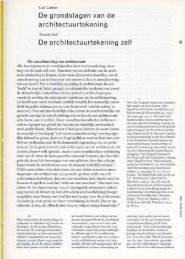Download PDF, 20 pages, 7.98 MB - Oase
Download PDF, 20 pages, 7.98 MB - Oase
Download PDF, 20 pages, 7.98 MB - Oase
Create successful ePaper yourself
Turn your PDF publications into a flip-book with our unique Google optimized e-Paper software.
tO ll<br />
Hunstaton Secondery Modern School, Zuidgevel, langsdoorsnede en plattegrond begane grond I South favade, longitudinal section and ground floor plan<br />
66
Finite orders and the art<br />
of everyday inhabitation<br />
The IIunstanton School by<br />
Alison and Peter Smithson<br />
Traditionally the fine arts depend on the popular arts<br />
for their vitality, and the popular arts jar their<br />
respectability. It has been said that things hardly 'exist'<br />
b({[ore the fine artist has made use of them; they are<br />
simply part of the unclassified background material<br />
against which we pass our lives. The traniformation<br />
from everyday object to fine art manifestation happens<br />
in many ways: the object can be discovered- objet<br />
trouve of art brut - the object itself remaining the<br />
same; ( .. ) or the object can be used as a jumping off<br />
point and is itself traniformed.<br />
Alison and Peter Smithson, Without Rhetoric, 1972<br />
Can buildings engage with the essentially non-archi<br />
tectural phenomena of everyday life, except by provid<br />
ing a more or less adequate background? For prewar<br />
Functionalism this question seemed to have found a<br />
definitive answer which relied on an understanding<br />
of function as a scientifically defined necessity. In<br />
spite of the various, often contradicting ideas as to<br />
how function and form might be related, the notion of<br />
function provided quantifiable parameters for archi<br />
tectural design in an industrial society. Architecture<br />
played an active part in a cultural and political project<br />
the def inition of which was as clear as it was bold;<br />
modern architecture as a means to achieve minimum<br />
standards for every individual independent of his or<br />
her social position.<br />
The notion of standard was an essential condition<br />
for achieving an equal distribution of means of the<br />
consumption; it did not answer the question how<br />
architecture might express the agenda for a social and<br />
democratic society, nor did it necessarily care much<br />
for the existing cultural patterns of the social classes<br />
for which it catered. The realism and non-judgemen<br />
tal interest in the everyday life of the urban working<br />
classes which we find in, say, Alfred Doblin's novel<br />
Berlin Alexanderplatz is absent in the discourse of<br />
modern architecture. The culture of everday life was<br />
the product of a utopian project, mediated through the<br />
architectural vocabulary of Functionalism; not a rich<br />
and valuable source of inspiration or field of research.<br />
When building started in Europe after the war it<br />
seemed for a short time that the programme of the<br />
prewar avantgardes provided the guidelines along<br />
which the gargantuan task of reconstructing the cities<br />
could be fulfilled. Yet, within less than a decade the<br />
fault-lines, which would eventually undermine the<br />
delicate consensus that had characterised modern<br />
Christoph Grafe<br />
67<br />
Eindige ordes en de kunst van<br />
de alledaagse bewoning<br />
De Hunstanton School van<br />
Alison en Peter Smithson<br />
Traditionall'h the fine arts depend on the popular arts for their<br />
vitalil'h and the popular arts for their respectability. It has<br />
been said that things hardly 'exist' before the fine artist has<br />
made use of them; they are simply part of the unclassified<br />
background material against which we pass our lives. The<br />
transformation from everyday object to fine art manifestation<br />
happens in many ways: the object can be discovered- objet<br />
trouve or art brut- the object itself remaining the same; ( .. .)<br />
or the object can be used as a jumping off point and is itself<br />
transformed.<br />
Alison en Peter Smithson, Without Rhetoric, 1972<br />
Kunnen gebouwen zich op een andere manier dan als min<br />
of meer geschikte achtergrond verhouden tot de uiteindelijk<br />
niet-architectonische fenomenen van het alledaagse Ieven?<br />
Het vooroorlogse functionalisme leek op deze vraag een<br />
definitief antwoord te hebben gevonden; een antwoord dat<br />
steunde op het begrip van de functie voortkomend uit een<br />
wetenschappelijk gedefinieerde noodzaak. Ondanks het feit<br />
dat er vele, elkaar vaak tegensprekende ideeen bestonden<br />
over hoe vorm en functie gerelateerd konden zijn, voorzag<br />
de functie in kwantificeerbare parameters voor architecto<br />
nisch ontwerpen in een industriele samenleving. Architec<br />
tuur speelde een actieve rol in een culturele en politieke<br />
agenda. De omschrijving van deze agenda was even helder<br />
als uitgesproken: moderne architectuur was een middel om<br />
minimumstandaards te bereiken voor ieder individu,<br />
onafhankelijk van zijn of haar sociale positie.<br />
De notie van een standaard vormde een essentiele voor<br />
waarde voor het bereiken van een rechtvaardige distributie<br />
van consumptiemiddelen; ze gaf geen antwoord op de vraag<br />
op welke manier architectuur de agenda voor een sociale en<br />
democratische samenleving zou kunnen uitdrukken, en<br />
evenmin werd er rekening gehouden met de bestaande<br />
culturele patronen van de sociale klassen waarvoor men<br />
het opnam. Het realisme en de onbevooroordeelde belang<br />
stelling voor het alledaagse Ieven van de gewone stadsbe<br />
woner die we bijvoorbeeld in Alfred Doblins roman Berlin<br />
Alexanderplatz vinden, zijn afwezig in het discours van de<br />
moderne architectuur. De cultuur van het alledaagse Ieven<br />
was eerder het product van de utopische onderneming,<br />
waarbij de architectonische taal van het functionalisme als<br />
bemiddelaar optrad, niet als een rijke en waardevolle bron<br />
van inspiratie of een veld van onderzoek.<br />
Toen men na de oorlog weer begon te bouwen, leek het<br />
voor een korte periode erop dat de uitgangspunten van de<br />
vooroorlogse avant-gardes nog steeds bruikbaar waren om<br />
de enorme taak van de wederopbouw van de Europese<br />
steden te realiseren. Binnen tien jaar werden echter de<br />
OASE # 49/50 1998
GBRK CUURT OR'l'B<br />
8 ) 10 tt 12<br />
tO tt<br />
Noordgevel, dwarsdoorsnedes en plattegrond eerste verdieping I orth fa
architecture, clearly showed. Ironically, it was in<br />
England, the fringe province of European prewar<br />
Modernism, where the relation between architectural<br />
form and emerging postwar mass culture was put on<br />
the agenda with great urgency and informed the<br />
debates among architects and their artist friends. The<br />
question if and how a building should engage with<br />
the images, rituals or social agreements that organise<br />
modern life provided a grand theme for architectural<br />
practice and theory. While this debate was by no<br />
means exclusively English, nowhere else in Europe<br />
were its implications discussed more critically and<br />
passionately.<br />
Alison and Peter Smithson's school in the Norfolk<br />
village of Hunstanton is a key building which both<br />
precedes and embodies this debate in the London<br />
architectural scene. It figures in an article of 1955 by<br />
Rey ner Banham as an exercise in the New Brutalism,<br />
much before the word was coined and became com<br />
monly used. Designed in 1949, four years after the<br />
land-slide Labour victory provided the background<br />
for the British welfare state, the Hunstanton school<br />
introduced a Miesian variation of international mod<br />
ernism within the context of the ambitious school<br />
building programme of the new administration. At the<br />
same time there were signs of a significant change of<br />
direction in the interests of the architects, a change<br />
which became apparent in the carefully orchestrated<br />
presentation of the finished building, five years later.<br />
While the school was still under construction the<br />
Schoolplein met op de voorgrond het bijgebouw van de keuken (1954) I<br />
School yard with, in Lhe foreground, lhe outbuilding for the kitchen (1954)<br />
69<br />
breuklijnen, die uiteindelijk de delicate consensus die zo<br />
kenmerkend was voor de moderne architectuur, zouden<br />
ondermijnen, duidelijk zichtbaar. lronisch genoeg werd uit<br />
gerekend in Engeland, Europa's buitengewest van het voor<br />
oorlogse modernisme, de relatie tussen architectonische<br />
vorm en de opkomende naoorlogse massacultuur met grote<br />
urgentie op de agenda gezet. Architecten en hun kunste<br />
naarsvrienden debatteerden hevig over de kwestie. Het<br />
hete hangijzer voor de architectuurpraktijk en -theorie was<br />
de vraag of en hoe een gebouw kon inspelen op de beelden,<br />
rituelen en sociale overeenkomsten die het moderne Ieven<br />
organiseren. Dit debat vond zeker niet aileen in Grot<br />
Brittannie plaats, maar nergens in Europa werden de impli<br />
caties kritischer of hartstochtelijker besproken.<br />
De school in Hunstanton in Norfolk, ontworpen door<br />
Alison en Peter Smithson, is een sleutelgebouw dat aan dit<br />
debat in Londense architectenkringen voorafgaat en het<br />
tevens belichaamt. De school figureert bij Reyner Banham<br />
als een oefening in het brutalisme, lang voordat dit begrip<br />
opkwam en algemeen gebruikt werd. De school te<br />
Hunstanton werd ontworpen in 1949, vier jaar nadat de<br />
grote verkiezingsoverwinning van Labour de basis voor de<br />
Britse verzorgingsstaat had gelegd. Het introduceerde een<br />
Miesiaanse variatie op het internationale modernisme, pas<br />
send binnen de context van het ambitieuze scholenbouw<br />
programma van de nieuwe regering. In de nauwkeurig geor<br />
kestreerde presentatie van het voltooide gebouw- vijf jaar<br />
later- werd een duidelijke verandering in de belangstelling<br />
van de architecten zichtbaar. Terwijl de school nog in aan<br />
bouw was ontdekten de architecten de nieuwe wereld van<br />
OASE # 49/50 1998
architects discovered the new world of images and<br />
forms produced by postwar, mainly American, mass<br />
culture which was to inform their subsequent work as<br />
well as their reading of this first early school building.<br />
A school in Norfolk<br />
The Smithsons' building was part of a school building<br />
campaign during which a new school was finished<br />
virtually every day in England and Wales between<br />
1950 and 1970. As Andrew Saint pointed out, this<br />
wave of school building was 'the fullest expression of<br />
the movement for a social architecture' of the emerg<br />
ing British welfare state. English school building<br />
(along with equally ambitious efforts in Denmark)<br />
acquired model status for other European Social<br />
Democracies.<br />
The Hunstanton School is situated on what used to<br />
be the outskirts of Hunstanton. Now absorbed by post<br />
war terraces and a variety of rather incongruous<br />
offices, sheds and garages, it is not that easy to imag<br />
ine the flat and very open Norfolk countryside that<br />
surrounded the site at the time of the construction.<br />
The small shrubs and single trees that enclose the<br />
school's sports fields and which on period pho<br />
tographs seem bare and humble as if not to interfere<br />
with the enormous scale of the horizon and the land<br />
scape, have grown into irregular greenery, unsuccess-<br />
Gymzaal gezien vanuit het noorden (1954) I Gymnasium as seen from the north (1954)<br />
70<br />
beelden en vormen die het gevolg waren van de<br />
- voornamelijk Amerikaanse- naoorlogse massacultuur.<br />
Een school in Norfolk<br />
Het gebouw van de Smithsons maakte deel uit van een<br />
scholenbouwcampagne die tussen 1950 en 1970 bijna dage<br />
lijks de voltooiing van een nieuwe school in Engeland en<br />
Wales teweeg kon brengen. Zoals Andrew Saint opmerkte,<br />
was deze golf van scholenbouw 'de duidelijkste uitdrukking<br />
van de beweging voor een sociale architectuur' van de opko·<br />
mende Britse verzorgingsstaat. Het Engelse scholenbouw<br />
programma had (samen met de even ambitieuze inspannin<br />
gen in Denemarken) een modelstatus voor andere Europese<br />
sociale democratieen.<br />
De Hunstanton School ligt op een plek die ooit de rand<br />
van Hunstanton was. Nu wordt het terrein geabsorbeerd<br />
door naoorlogse rijtjeshuizen en een verscheidenheid aan<br />
onooglijke kantoorgebouwen, schuren en garages, en het<br />
valt niet mee om je het vlakke en uitgestrekte platteland van<br />
Norfolk voor te stellen dat het terrein tijdens de bouw om<br />
ringde. De kleine heesters en enkele bomen die de sportvel<br />
den van de school omsluiten en die op oude foto's verlaten<br />
en nietig overkomen, alsof ze de enorme schaal van de hori<br />
zon en het landschap niet wilden verstoren, hebben zich ont·<br />
wikkeld tot een onregelmatige begroeiing die zonder veel<br />
succes probeert de middelmatige ontwikkeling die Hunstan<br />
tons periferie sinds 1950 heeft doorgemaakt te verhullen.
fully trying to conceal the mediocre development that<br />
llunstanton's periphery has gone through since the<br />
1950s.<br />
Against this messy bacl\:ground which is the result<br />
of negligence and absence of planning, the ordered,<br />
long two-storey volume of the school displays an<br />
assuredness that makes it into an object which stands<br />
apart, something from another planet The building is<br />
made of rough brownish yellow brick, steel frames<br />
and panels not unlike those used for industrial build<br />
ing of the period and the colour scheme, black for<br />
the frames, yellowish white for the panels and red for<br />
the opening windows, is not overtly aiming for the<br />
spectacular. It is only when approaching the school<br />
that one can distinguish the order of the building, the<br />
skin of line vertical and horizontal lines produced by<br />
the steel transoms and mullions and the carefully<br />
proportioned blank brick surfaces that render the<br />
building into a defined object and mediate between<br />
the un-countable and repetitive and the singular form.<br />
Two one-storey out-buildings, one a satellite com<br />
pletely detached from the main building and advanc<br />
ing towards the street, the other recessed and con<br />
nected to the entrance hall, form an asymmetrical<br />
forecourt to the main entrace. Then there are the<br />
inevitable attributes of a school yard: bicycle sheds,<br />
an open area for the pupils and staff to gather and the<br />
school kitchen which is housed in the lower building<br />
attached to lhe main volume.<br />
-<br />
--"" ___ ... -==:-<br />
Tekening door Peter Smithson van de oostzijde van het gebouw met de watertank I<br />
Drawing by P
The familiarity of the ensemble is simultaneously<br />
supported and undermined by the vertical volume<br />
rising from a small service courtyard between the<br />
kitchen and the school building. Reminiscent of a<br />
clock tower it is in fact a raised water tank towering<br />
over the roofs of the building and the forecourt and<br />
adding an asymmetrical incident to the composition.<br />
Like the steel frames and panels the water tank is<br />
tal en from, or found, in the world of industrial build<br />
ing. In contrast to these components, however, it is a<br />
recognisable element that seems to have walked away<br />
from a different context, from a refinery or the Lop of<br />
a Brooklyn warehouse, to settle in a hazy field on the<br />
orfolk coast, as an exercise in industrial archeology.<br />
With its largely glazed facades and partitions the<br />
school and its internal layout become transparent<br />
almost immediately after entering the entrance hall;<br />
as it turns out the building contains two internal<br />
courtyards flanking the double height hall and sepa<br />
rated from it by glass partitions that follow the modu<br />
lar y tern of the perimeter facades. Flights of open<br />
steel stairs connect to the classrooms on the upper<br />
storey. The whole middle section of the ground floor<br />
is left open with dining areas on eiU1er side of the<br />
hall; in the outer parts enclosing the courtyards there<br />
are auxiliary rooms and administration offices. The<br />
gymna ium is a separate concise building of equal<br />
height a the main volume and po iUoned to the<br />
north of it. Less compromised by a differentiated brief<br />
it reveals a clear symmetry and a simple building<br />
gebouw. Dit volume doet denken aan een klokkentoren, maar<br />
bij nader inzien blijkt het een opgetilde watertank te zijn die<br />
boven de daken van het gebouw en het voorplein uittorent en<br />
een asymmetrisch incident toevoegt aan de compositie.<br />
Net als het stalen frame en de panelen stamt ook deze<br />
watertoren uit de wereld van de industriele gebouwen, maar<br />
in tegenstelling tot deze componenten is de toren een her<br />
kenbaar element dat lijkt te zijn weggelopen uit een andere<br />
context, een raffinaderij of het dak van een pakhuis in<br />
Brooklyn om hier in een heiig wei land aan de Norfolkse kust<br />
te staan als een oefening in industriele archeologie.<br />
Vrijwel onmiddellijk na binnenkomst in de entreehal<br />
wordt de interne opzet van het gebouw duidel ijk; het blijkt<br />
twee binnenpleinen aan weerszijden van de dubbelhoge hal<br />
te bevatten, gescheiden door glazen tussenwanden die het<br />
maatsysteem van de omliggende gevels volgen. Open stalen<br />
trappen leiden naar de klaslokalen op de verdieping. Het<br />
hele middengebied van de begane-grondvloer is open gela<br />
ten met eetruimten aan beide zijden van de hal; in de buiten<br />
ste delen die de binnenplaatsen omsluiten bevinden zich de<br />
kantoortjes voor de administratie en de nevenruimten. De<br />
gymzaal is een apart compact gebouw van gelijke hoogte als<br />
het hoofdgebouw en ligt ten oosten hiervan. Minder gecom<br />
promitteerd door een gedifferentieerd programma vertoont<br />
het een duidelijke symmetrie en de eenvoudige hierarchie<br />
van een staalconstructie met invullingen van glas en<br />
baksteen.<br />
Zuidzijde schoolgebouw met gymzaal (1954) I South side main building and gymnasium (1954)<br />
72<br />
Door de afwezigheid van gangen is de verkeersruimte tot<br />
een minimum beperkt en zijn de klaslokalen direct toeganke<br />
lijk vanuit de hal. De plattegrond is zeer compact. Het
order of teel frames with glass and brick infil1s.<br />
With the circulation space reduced to a minimum<br />
b amiding corridors and by offering direct acces to<br />
the classrooms from the hall this is a very tight plan.<br />
It is through the use of elegantly modulated glass skins<br />
and slender steel columns and beams that the school<br />
keeps a sense of openness. The primary structure con<br />
sists of partly prewelded steelframes which were cal<br />
culated using plastic theory, a method of calculating<br />
structural dimensions aimed at achieving an extreme<br />
economy. Where necessary secondary structural ele<br />
ments like brick infills and facing frames act as lateral<br />
bracing for the structural frames and contribute to<br />
r'etaining the thinness of the construction.<br />
The period photographs taken by Nigel Henderson<br />
are poignant illustrations of the architects' intentions.<br />
From the bare interiors, photographed without furni<br />
ture 'at the architects' request' as the slightly bewil<br />
dered editor of the Architectural Review noted, we look<br />
into the courtyards and beyond, through everal layers<br />
of glass which are not so much transparent sheets but<br />
screens that frame and define the view.1 The evenly<br />
spaced transoms and mullions establishing orthogonal<br />
planes at various distances from the camera's view<br />
point merge into an image of lines, the nearer blurred<br />
and therefore strangely intangible, the farther ones<br />
'School atllunstan to n, o rfolk (including: co mment by<br />
Philip Johnson as an \meric an foll ower of Mies van der Rohe)',<br />
'f1ze Jrchileclural Review, September, 1954, p. 148- t 52.<br />
lnterieur hal (1954) I Interio r hall (1954)<br />
73<br />
gebruik van elegant verdeelde glazen huiden en slanke sta<br />
len kolommen en liggers schept een indruk van openheid.<br />
De hoofdconstructie bestaat uit gedeeltelijk voorgelaste<br />
stalen geraamten die berekend zijn volgens de plastic theo<br />
ry, een methode om structurele dimensies te berekenen,<br />
gericht op het bereiken van een extreme economie van het<br />
materiaal. Secundaire constructie-elementen zoals de bak<br />
stenen invullingen doen mee in de hoofdconstructie en dra<br />
gen bij tot het behoud van de slankheid van de constructie.<br />
De ten tijde van de oplevering genomen toto's van Nigel<br />
Henderson geven een duidelijk beeld van de bedoelingen<br />
van de architecten. Vanuit het kale interieur, 'op verzoek van<br />
de architecten' zonder meubels gefotografeerd, zoals de<br />
enigszins verbijsterde redacteur van de Architectural<br />
Review opmerkte, kijken we uit over de binnenplaatsen en<br />
wat daar achter ligt, door verschillende lagen glas die niet<br />
zozeer glazen vliezen zijn, eerder schermen die het zicht<br />
inkaderen en definieren.1 De gelijk verdeelde horizontale en<br />
verticale balken vermengen zich tot een beeld van lijnen<br />
hoe dichterbij hoe vager en daardoor op een vreemde<br />
manier ontastbaar, hoe verder hoe afstandelijker en<br />
verdwijnend in een neve! van stof en Iicht.<br />
Het is alsof de wittige ondefinieerbare substanties die<br />
het landschap in een film van Federico Fellini veranderen in<br />
decors van malinconia, zich meester hebben gemaakt van<br />
dit nieuwe schoolgebouw in het naoorlogse Engeland. Wat<br />
'School at Hunstanton, Norfolk (including: comment by Philip Johnson as<br />
an American follower of Mies van der Rohe)', The Architectural Review,<br />
september 1954, p. 148-152.<br />
OASE # 49/50 1998
disappearing into a magic haze of dust and light.<br />
It i as if the whitish undefineable substances that<br />
turn the landscapes of Antonioni's films or Federico<br />
Fellini's Amacord into settings of malinconia had set<br />
tled on this new school building in post-war England.<br />
What we see is construction in its purest sense, not as<br />
a technical achievement, but as an ordered, simple,<br />
yet eminently elegant composition of structural ele<br />
ments each of which has a specific material quality.<br />
As the Architectural Review put it, the architects con<br />
ceived the steel 'as a unique material - not as a kind<br />
of ab tract stiffness cut to length, but as a ductible,<br />
weldable substance witl1 elastic and plastic limits, a<br />
surface, feel and appearance of its own to be appreci<br />
ated and used as Queen Anne builders used brick or<br />
Regency engineers used stone?2 The material steel<br />
and brick surfaces are not concealed, nor is there an<br />
attempt to make them cheerful.<br />
Despite, or perhaps because of, the exposure of the<br />
common properties of its structure and material, the<br />
IIunstanton School is above all an architectural state<br />
ment, an artful building which almost incidentally<br />
happens to house an educational institution. Both its<br />
layout and its material appearance contrast starkly<br />
with the predominantly picturesque planning of<br />
English modernist school building of the period. The<br />
compact and symmetrical plan rejects the loose distri<br />
bution of volumes that had become one of the hall<br />
marks of functionalist planning introduced to Britain<br />
by Gropius's Impinton College of 1938-1942 and the<br />
we zien is constructie in de meest pure zin van het woord,<br />
niet als technische prestatie, maar als een geordende,<br />
simpele doch zeer elegante compositie van constructie<br />
elementen, die elk een eigen materiele kwaliteit bezitten.<br />
Zoals de Architectural Review het omschreef, ontdekten de<br />
architecten het staal 'als een uniek materiaal- niet als een<br />
soort abstracte stijfheid die op maat gesneden is, maar als<br />
een rekbare, smeedbare substantie met eigen elastische en<br />
plastische limieten, oppervlakte, gevoel en verschijning die<br />
gewaardeerd dient te worden, vergelijkbaar met de manier<br />
waarop baksteen gebruikt werd door Queen-Anne-bouwers,<br />
of steen door de Regency-ingenieurs.'2 De stalen en stenen<br />
oppervlakken worden niet verborgen, noch wordt gepro<br />
beerd ze vrolijk te maken.<br />
Trappen aan weerzijden van het entreegebied (1954) I Staircases at either end of tbe entrance foyer (1954)<br />
74<br />
Ondanks, of misschien dankzij de blootstelling van de<br />
eigenschappen van de constructie en het materiaal is de<br />
Hunstanton School bovenal een architectonisch statement.<br />
Een gebouw dat bijna bij toeval een onderwijsinstelling<br />
huisvest. Zowel de opzet als de materiele verschijning<br />
steken scherp af tegen de gang bare pittoreske planning van<br />
de Engelse modernistische scholenbouw van die periode.<br />
Het compacte en symmetrische plan verwerpt de losse ver<br />
deling van volumes die tot een van de karakteristieken van<br />
de door Gropius' lmpinton College uit 1938-1942 in Groot<br />
Brittannie ge"fntroduceerde functionalistische planning was<br />
geworden. Ook de populistische mengeling van baksteen<br />
en dakpannen, een van de kenmerken van de politieke cor<br />
rectheid in de jaren veertig en gepropageerd door de vul<br />
gair-marxistische fractie binnen het architectenbureau van<br />
de London County Council, wordt in dit gebouw verworpen.a
supposedly popular mix of brick and tiled roofs which<br />
was one of the 1940s ideas of political correctness as<br />
propagated by the vulgar Marxist fraction within the<br />
arch itects' office of the London County Council.3<br />
The Palladian Revival<br />
In 1949 the Berlin-born architectural historian Rudolf<br />
Wittkower collected and republished a series of arti<br />
cles on Renaissance architecture which he had writ<br />
ten during the war. Architectural Principles in the Age<br />
of Jlumanism was not only the result of careful<br />
knowledgelabe study, it fundamentally re-examined<br />
the traditional view of quattrocento architecture as a<br />
departure from the religiously motivated building<br />
practice of the Middle Ages. Rather than accepting the<br />
\ iew that the centralized plans and the reference to<br />
antiquity were a result of a worldly 'pagan' attitude<br />
Ibid., p. 152.<br />
3<br />
Thr specific architectural interest<br />
hich infor·med the design is<br />
apparrnl when it is compared with<br />
the results of the school building<br />
campaign initialed and carried out by<br />
thr English county of Hertfortshire.<br />
Thr mith on rejected the Hills 8'3"<br />
system which relied on prefabrica<br />
tion of laJ'ger building elements for<br />
its crudenes . See: Andrew Saint, Not<br />
a Building, but a Method of Building,<br />
I lerlford, 1990, and by the same<br />
author, Towards a Social<br />
Architecture, The Role qf School<br />
Building in Post-War England, cw<br />
llaven I London, 1987.<br />
Foto Nigel Henderson I Photograph igel Tlcnderson<br />
75<br />
De Palladiaanse wederopleving<br />
In 1949 verzamelde de in Berlijn geboren architectuur<br />
historicus RudolfWittkower een serie artikelen over<br />
renaissance-architectuur die hij tijdens de oorlog had<br />
geschreven, en liet deze opnieuw publiceren. Architectural<br />
Principles in the Age of Humanism was niet aileen het resul<br />
taat van een zorgvuldige en kundige studie, maar ook een<br />
heronderzoek van de architectuur van het Quattrocentro als<br />
een afwijzing van de religieus gemotiveerde bouwpraktijk<br />
van de middeleeuwen. In plaats van de opvatting te accep<br />
teren dat de centrale plattegronden en de referentie aan de<br />
oudheid het resultaat zouden zijn van een wereldlijke, 'hei<br />
dense' houding die de preoccupatie met het transcendente<br />
van de middeleeuwse architectuur verwierp, voerde<br />
Wittkower het argument aan dat de zoektocht naar de pure<br />
geometrie gebaseerd was op een hierarchie van waarden<br />
die haar hoogtepunt bereikte in de absolute waarden van de<br />
geheiligde architectuur.4 De harmonische perfectie, geba-<br />
Ibidem, p. 152.<br />
3<br />
De specifieke architectonische belang<br />
stelling die het ontwerp be'fnvloedde<br />
wordt duidelijk wanneer het wordt<br />
vergeleken met de resultaten van de<br />
scholenbouwcampagne ge'fnitieerd en<br />
uitgevoerd door het Engelse graaf<br />
schap Hertfordshire. De Smithsons<br />
verwierpen het Hills 8'3" systeem, dat<br />
gebaseerd was op prefabricatie van<br />
grotere bouwelementen, vanwege de<br />
grofheid ervan. Zie: Andrew Saint, Not<br />
a Building, but a Method of Building,<br />
Hertford, 1990, en van dezelfde auteur:<br />
Towards a Social Architecture, The Role<br />
of School Building in Post-War<br />
England, New Haven I Londen, 1987.<br />
4<br />
RudolfWittkower, Architectural<br />
Principles in the Age of Humanism,<br />
Londen, 1949, p. 15; Ned. vert.<br />
Grondbeginselen van de architectuur<br />
in het tijdperk van het humanisme,<br />
Nijmegen, 1996.<br />
OASE # 49150 1998
ejecting the preoccupation with the transcendental<br />
of mediaeval architecture, Wittkower argues that the<br />
search for pure geometry was based on a hierarchy of<br />
values culminating in the absolute values of sacred<br />
architecture.4 Based on mathematically defined pro<br />
portion the harmonic perfection represents absolute<br />
value. 'P'or Alberti- as for other Renaissance artists<br />
this man-created harmony was a visible echo of a<br />
celestial and universally valid harmony'.5 Wittkower<br />
emphasizes the conviction of Renaissance architects<br />
that universal harmony could only be revealed in<br />
architecture conceived in the service of religion. Pure<br />
geometric form embodies the religious principle.<br />
That Wittkower's book fell on fertile ground and<br />
was especially widely read by the younger generation<br />
of English architects including Alison and Peter<br />
Smithson is beyond doubt. In their reaction to<br />
criticism of the book in the Architectural Review the<br />
Smithsons were extraordinarily explicit about their<br />
appreciation. Following Siegfried Giedeon they rank<br />
Architectural Principles together with Le Corbusier's<br />
Modular as the most important book of the Post-War<br />
years and state that Wittkower was 'regarded by the<br />
younger architects as the only art-historian working<br />
in England capable of describing and analysing build<br />
ings in spatial and plastic terms, and not in terms of<br />
derivations and dates'.6<br />
Reyner Banham identifies Wittkower's book as one<br />
source of the interest in classicism prevailing in the<br />
London architectural scene of the late 1940s and early<br />
seerd op wiskundig gedefinieerde properties, representeert<br />
absolute waarde. 'Voor Alberti- en andere renaissance<br />
kunstenaars- was deze door de mens gemaakte harmonie<br />
een zichtbare echo van een hemelse en universeel gelden<br />
de harmonie.'s Wittkower benadrukt de overtuiging van de<br />
renaissance-architecten dat universele harmonie aileen<br />
geopenbaard kan worden in architectuur die is verkregen in<br />
dienst van religie. Pure geometrische vorm belichaamt het<br />
religieuze principe.<br />
Er kan geen twijfel bestaan dat Wittkowers boek bijzon<br />
der invloedrijk was en juist door de jongere generatie<br />
Engelse architecten, onder wie Alison en Peter Smithson,<br />
veel werd gelezen. In hun reactie op een kritiek op het boek<br />
in de Architectural Review waren de Smithsons zeer<br />
expliciet over hun waardering. In navolging van Siegfried<br />
Giedeon rekenden zij Wittkowers boek sa men met Le<br />
Corbusier's Modular tot de belangrijkste boeken van de<br />
naoorlogse jaren. Zij stelden dat Wittkower 'door de jongere<br />
architecten werd gezien als de enige kunsthistoricus<br />
werkzaam in Engeland die in staat was gebouwen in ruimte<br />
lijke en beeldende termen te beschrijven en analyseren,<br />
in plaats van in genealogieen en data' .6<br />
Reyner Ban ham identificeert Wittkowers boek als de<br />
bron van de belangstelling voor het classicisme die in de<br />
Londense architectuurscene tegen het einde van de jaren<br />
veertig en het begin van de jaren vijftig overheerste. Ook<br />
interpretaties van Le Corbusier wekten deze belangstelling<br />
op. Banham herinnert zich dat aile jongere architecten 'zeer<br />
sterk onder de invloed kwamen van de briljante heropleving<br />
van Palladiaanse studies in het Engeland aan het einde van<br />
Nigel Hendersons fotocollage zoals gepubliceerd in de Architectural Review I Nigel Henderson's photo collage as published in Architectural Review<br />
76
1950s, which was also informed by readings of Le<br />
Corbusier. Banham remembers that all the younger<br />
architects 'came very directly under the influence of<br />
the brilliant revival of Palladian studies in England in<br />
the late Forties, either through Rudolf Wittkower, or<br />
through the teaching of his outstanding pupil Colin<br />
Rowe'.7 Despite the explicitness of the statement<br />
Banham does not offer much insight as to how the<br />
supposed influence materialised in the architectural<br />
work; the reader is invited to read the symmetry and<br />
geometric clarity of Hunstanton for evidence. He<br />
maintains that it was through a study of classicising<br />
tendencies in the work of modern masters - Mies and<br />
Le Corbusier in particular - that these sensibilities<br />
found their way into the designs of architects like<br />
John Voelcker and the Smithsons.<br />
The question remains as to how the influence of<br />
Architectural Principles can be defined if it is less<br />
direct than the initial outspoken adhesion on the part<br />
of the Smithsons might suggest. In a scholarly article<br />
that investigates the influence of Wittkower's book on<br />
Rudolf Wittkower, Architectural<br />
Principles in the Age of Humanism,<br />
London, 1949, p. 15.<br />
5<br />
Ibid., p. 18.<br />
6<br />
RIBA Journal, 59, 1952, p. 140.<br />
an isometric view of the facina fn.mes as welded<br />
toaether for boltint to the structural work.<br />
de jaren veertig, ofwel door Rudolf Wittkower, ofwel door<br />
de lessen van zijn uitzonderlijk begaafde leerling Colin<br />
Rowe'.7 Ondanks de duidelijkheid van deze uitspraak<br />
geeft Banham niet veel inzicht in de manier waarop de<br />
veronderstelde invloed tot uiting komt in het architectoni<br />
sche werk; de lezer wordt uitgenodigd de symmetrische en<br />
geometrische helderheid van Hunstanton te lezen ter<br />
bewijs. Hij houdt vol dat deze sensibilities hun weg vonden<br />
in de ontwerpen van architecten als John Voelcker en de<br />
Smithsons via bestudering van de classicerende tenden<br />
sen in het werk van moderne meesters als Mies en<br />
Le Corbusier.<br />
De vraag blijft echter hoe de invloed van Architectural<br />
Principles kan worden gedefinieerd als deze minder direct<br />
is dan de in het begin door de Smithsons uitgesproken<br />
waardering doet vermoeden. In een artikel waarin hij de<br />
invloed van Wittkowers boek op de ontwikkeling en de<br />
interpretatie van de moderne architectuur onderzoekt,<br />
onderscheidt de Amerikaanse kunsthistoricus Henry<br />
A. Millon drie ontwikkelingen in het Britse architectuur<br />
wereldje van de jaren vijftig.a Allereerst heeft het boek<br />
Reyner Banham, The New Brutalism, Ibidem, p. 18. 8<br />
London, 1966, p. 15. Banham 6<br />
published this text as an article in the RIBA Journal, 59, 1952, p. 140.<br />
Architectural Review of December 7<br />
1955. The book is a revised and Reyner Ban ham, The New Brutalism,<br />
enlarged version of the article. Londen, 1966, p. 15. Banham publiceer<br />
de deze tekst als artikel in de<br />
Architectural Review van december<br />
1955. Het boek is een herziene en<br />
lsonometrie van de gelaste gevelframes die door middel van bouten op de hoofdconstructie zijn bevestigd I<br />
lsonometric view of the facing frames as welded together for bolting to the structural work<br />
Detail verticaal schuifraam I Detail vertical sliding window<br />
77<br />
···'tz-'!:fk4 fy<br />
u--<br />
vertlcaltlldlna window and pt-etsed steel<br />
esbolc:edto fac:ina frame.<br />
uitgebreide versie van het artikel.<br />
Henry A. Millon, 'RudolfWittkower,<br />
Architectural Principles in the Age of<br />
Humanism: Its Influence on the<br />
Development and Interpretation of<br />
Modern Architecture', Journal of the<br />
Society of Architectural Historians<br />
(VS), 1972, p. 83-91.<br />
OASE # 49150 1998
the development and interpretation of modern archi<br />
tecture the American art historian Henry A. Millon<br />
identifies three developments in the British architec<br />
tural scene during the 1950s.s First, the book is shown<br />
to have informed a renewed interest in modular con<br />
struction, a matter of great concern in the reconstruc<br />
tion efforts of the postwar years. The second line of<br />
influence investigated by Millon is the contribution to<br />
the debate on proportion and composition. By empha<br />
sising the connection between humanist religious<br />
thinking and proportion theory and its translation<br />
into Renaissance architectural practice, Wittkower<br />
opened up the issue for contemporary architects<br />
resulting in a vivid and ongoing debate; in this debate<br />
in the Smithsons intervened several times, specifically<br />
in 1957 when in a RIBA meeting a motion was<br />
brought forward claiming 'that systems of proportion<br />
make good design easier and bad design more<br />
difficult'. In the discussion held before the voting Peter<br />
Smithson made a remakable statement that reveals<br />
much about the architects' shifting position after the<br />
Hunstanton design, and more than that, it reads like<br />
a fragment of an intellectual autobiography. Smithson<br />
argues that Architectural Principles was such a suc<br />
cess when it appeared because issues of proportion<br />
were 'important to architects as a matter of tooth and<br />
claw debate, in 1948 and 1949'. In their search for a<br />
definition of an architectural system and a building<br />
order, architects (i.e. the Smithsons) had looked at<br />
Renaissance buildings to find 'something that stood<br />
above what they were doing themselves'. In 1957, with<br />
Britain and the rest of Western Europe on their way to<br />
becoming a consumer society, that moment had pas<br />
sed. In a rhetorical move which makes a shift of ideas<br />
held by a tiny group of people into something of a<br />
Zeitgeist development Smithson gives the final verdict;<br />
a judgement which his later work proves to be precip<br />
itous. Smithson bluntly states that 'the right time for<br />
the Palladian Revival was 1948'.9<br />
If the interest in proportion theory was of a pas<br />
sing nature and had always been indirect, via the<br />
reinterpretation of modernist work, the question con<br />
cerning the relevance of Architectural Principles re<br />
mains open. Millon identifies a third line of influence<br />
which he claims to have outlasted the momentary<br />
impact after the publication of the book. In his view<br />
Wittkower was of fundamental importance for the<br />
reassessment of prewar Modern architecture itself<br />
which continued to be the core project of the English<br />
avantgarde of the 1950s and 1960s - and has proved<br />
to be far from dead in the nineties. He regards the<br />
'emphasis on the integral societal or cultural<br />
significance of the forms, methods and proportions<br />
employed by architects in the Renaissance' 1o as highly<br />
influential for the efforts to re-examine the ideological<br />
drift and cultural intentions of the Modern Movement.<br />
'Wittkower's exposition of the relationship between<br />
architecture and society came at a time when it could<br />
serve as an apt methodological model for a revision of<br />
view about twentieth century architecture?11 Not only<br />
78<br />
een hernieuwde interesse in modulaire constructie op<br />
gang gebracht; een onderwerp van groot belang voor de<br />
naoorlogse wederopbouw. Een tweede invloedslijn is de<br />
bijdrage aan het debat over proportie en compositie.<br />
Door de relatie te benadrukken tussen het humanistische<br />
religieuze denken en de proportieleer en haar vertaling<br />
in de architectuurpraktijk van de renaissance, maakte<br />
Wittkower het onderwerp toegankelijk voor de hedendaag<br />
se architecten. Dit vond zijn weerslag in een levendig en<br />
langdurig debat; een debat waarin de Smithsons herhaal<br />
delijk intervenieerden en dat in 1957 zijn hoogtepunt<br />
bereikte to en op een Rl BA-bijeenkomst de volgende<br />
motie naar voren werd gebracht: 'proportiesystemen<br />
maken goed ontwerpen makkelijker en slecht ontwerpen<br />
moeilijker'. In de discussie die voorafging aan de beslis<br />
sing maakte Peter Smithson een opvallende opmerking<br />
waaruit duidelijk werd hoezeer zijn positie sinds het<br />
Hunstanton-ontwerp veranderd was. De opmerking kan<br />
men lezen als een fragment uit een intellectuele biografie.<br />
Smithson zegt dat Architectural Principles zo'n groot suc<br />
ces was toen het verscheen omdat de studie van proper<br />
ties 'voor architecten in 1948 en 1949 zeer belangrijk was,<br />
een kwestie van Ieven of dood'. Architect en (hier: de<br />
Smithsons) zochten naar een definitie van een architecto<br />
nisch systeem en een hierarchie en bestudeerden de<br />
renaissance-gebouwen om 'iets te vinden dat verder ging<br />
dan wat zij zelf deden'. In 1957, toen Groot-Brittannie en<br />
de rest van West-Europa op weg waren een consumptie<br />
maatschappij te worden, was dat moment alweer voorbij.<br />
In een nogal retorische opmerking die de ideeen van een<br />
kleine groep mensen interpreteert als een algemene ont<br />
wikkeling van de Zeitgeist, geeft Smithson het definitieve<br />
oordeel: 'het juiste tijdstip voor een Palladiaanse weder<br />
opleving was 1948'.9<br />
Als de belangstelling voor de proportieleer van<br />
tijdelijke aard was en altijd indirect was geweest, via de<br />
herinterpretatie van het modernisme, blijft de vraag van<br />
de relevantie van Architectural Principles onbeantwoord.<br />
Millon ondersc.heidt een derde invloedslijn die volgens<br />
hem op de langere termijn van meer invloed was dan de<br />
tijdelijke impact van het boek direct na uitgave. Hij is van<br />
mening dat de fundamentele invloed van Wittkower lag in<br />
de kritische herwaardering van de vooroorlogse moderne<br />
architectuur die in het vervolg de kern vormde van de<br />
Engelse avant-garde van de jaren vijftig en zestig- en<br />
ook in de jaren negentig allesbehalve doodgebloed is. Hij<br />
beschouwt de 'nadruk op het integrale sociale en culturele<br />
belang van de vormen, methoden en properties zoals de<br />
renaissance-architecten die kenden'1o als van zeer grote<br />
invloed op de pogingen om de ideologische drijfveren en<br />
culturele bedoelingen van de Moderne Beweging opnieuw<br />
te onderzoeken. 'Wittkowers uiteenzetting van de relatie<br />
tussen architectuur en samenleving kwam op een tijdstip<br />
waarop het kon dienen als doelmatig methodologisch<br />
model voor een revisie van de kijk op architectuur van de<br />
twintigste eeuw.11 Deze aanpak was onder andere verant<br />
woordelijk geweest voor een hernieuwde interesse in de<br />
klassieke erfenis van de moderne architectuur, waarvan<br />
het meest radicale voorbeeld te vinden is in Colin Rowe's<br />
beroemde artikei'The Mathematics of the Ideal Villa' uit
had this approach been responsible for a renewed<br />
interest in the classical heritage of Modern architec<br />
ture, most radically exemplified by Colin Rowe's sem<br />
inal article 'The Mathematics of the Ideal Villa' (1947).<br />
Its wider impact lay in the effect which the book had<br />
on what in the 1950s became known as Brutalism<br />
and its search for a conceptual framework for the<br />
relationship between cultural values in postwar soci<br />
ety and the operations of the architect. In that sense,<br />
it is suggested by Millon, Wittkower's book helped the<br />
Smith sons and other architects of their generation to<br />
formulate a vocabulary that successfully opposed both<br />
the loose functionalism of English Modernism and the<br />
'cheerful doodling' that, they said, characterised the<br />
work done for the 1951 Festival of Britain. With its<br />
insistence on the relation of cultural values and<br />
architectural form, however, it also accounted for the<br />
abandoning of the very same vocabulary soon after<br />
wards, a shift which in the case of the Smithsons took<br />
place while the Hunstanton school was still under<br />
construction.<br />
Jlenry A. Millon, 'Rudolf Wittkower,<br />
\rchitectural Principles in the Age of<br />
llumanism: lls Influence on the<br />
Development and Interpretation of<br />
Modern Architecture', Journal of the<br />
Society of Architectural Historians<br />
(USA), 1972, p. 83-91.<br />
9<br />
Report on U1e RlBA debate of 18 June<br />
1957, RIBA Journal, 64, 1957, p. 460-<br />
461, quoted from Millon. Smithson<br />
added 'lhe present interest in<br />
America in systems of proportion is<br />
just an academic postmor·tem of our<br />
European Post War impulse, as also<br />
is this debate at the RIBA'.<br />
10<br />
Millon, 'RudolfWittkower', p. 89.<br />
11<br />
Ibid., p. 88.<br />
Mies van der Rohe, Illinois Institute ofTechnology, Alumni Building, Chicago, 1946<br />
79<br />
1947. De grootste impact die het boek had ligt echter in<br />
zijn effect op het Brutalisme en de daarmee gepaard<br />
gaande zoektocht naar een conceptueel kader voor de<br />
relaties tussen culturele waarden in de naoorlogse<br />
samenleving en de verrichtingen van de architect. In die<br />
zin, aldus Millon, heeftWittkowers boek de Smithsons en<br />
andere architecten van hun generatie geholpen een taal<br />
te formuleren die zowel tegengesteld was aan het losse<br />
functionalisme van de Engelse modernisten als aan het<br />
'vrolijke gekrabbel' dat het werk voor het Festival of<br />
Britain van 1951 karakteriseerde. Met zijn aandacht voor<br />
de relatie tussen culturele waarden en architectonische<br />
vorm was het boek echter ook verantwoordelijk voor het<br />
verlaten van diezelfde taal niet veel later, een verschui<br />
ving die in het geval van de Smithsons plaatsvond terwijl<br />
de Hunstanton School nog in aanbouw was.<br />
Rapport van het RIBA-debat van 18<br />
juni 1957, RIBA Journal, 64, 1957,<br />
p. 460-461, overgenomen uit Millon.<br />
Smithson voegde eraan toe:<br />
'De huidige interesse in Amerika voor<br />
proportiesystemen is gewoon een<br />
postmortem van onze Europese<br />
naoorlogse impuls, net als dit debat<br />
hier bij de RIBA.'<br />
10<br />
Millon, 'RudolfWittkower', p. 89.<br />
11<br />
Ibidem, p. 88.<br />
OASE # 49/50 1998
Popular culture and the art of inhabitation<br />
Thr photographs by Nigel Henderson show a longing<br />
for· the rough-edged or, as Reyner Banham called it,<br />
the 'gcntlemanlike bloody-mindedness'l2 that is imme<br />
diate!) underneath the 'Palladian' gridded layout and<br />
the overt parallels with Mies' liT Campus buildings.<br />
l sing readily available steel sections the architects<br />
made a point of the economical and strategic use<br />
structural elements. This 'conglomerate ordering' pro<br />
duced the refinement which Philip Johnson admired<br />
in his review but it also accounted for some complica<br />
tions. Johnson describes one of these problems at the<br />
comer of the main hall where the frames and the grid<br />
inevitably interfere with each other. The solution to<br />
this problem, to put two separate slender columns next<br />
to rach other bears witness of a directness that makes<br />
John on shiver: 'Definitely not elegant?13 It is striking<br />
that the most radical violations against conventional<br />
architect ural wisdom and modernist usages almost go<br />
unnoticed. Johnson takes great care to overlook the<br />
usc of 'as found' elements, not only the water tank but<br />
also exposed pipes and precast floor elements which<br />
may be seen as a silent criticism of Mies' formalism.<br />
These 'as found' elements most clearly anticipate<br />
the earch for a more inclusive, 'aformalist' approach<br />
\\hlch is latent in the school design. As Henderson's<br />
12<br />
Hanham, The "vew Brutalism, p. 19.<br />
St. Hilda's College, Oxford, 1967<br />
13<br />
Architectural Review, September<br />
1954, p. 152.<br />
Prijsvraag Sheffield University I Sheffield University competition, 1953<br />
81<br />
Populaire cultuur en de kunst<br />
van het alledaagse Ieven<br />
De foto's van Nigel Henderson Iaten een verlangen naar<br />
ruwheid zien of, zoals Reyner Banham het noemde, de gen<br />
tleman/ike b/oody-mindedness12 die direct onder de<br />
'Palladiaanse' orthogonale layout en de openlijke parallel<br />
len met Mies' liT -campusgebouwen verscholen ligt. Door<br />
het gebruik van geprefabriceerde stalen elementen pro<br />
beerden de architecten constructie-elementen economisch<br />
en strategisch te gebruiken. Het is deze conglomerate orde<br />
ring die volgens Peter Smithson zorgde voor de verfijndheid<br />
die Philip Johnson in zijn bespreking zo bewonderde, maar<br />
die ook enkele complicaties met zich meebracht. Johnson<br />
beschrijft een van deze problemen aan de hand van de hoek<br />
van de grote hal waar de stalen portalen en het grid onont<br />
koombaar met elkaar in de knel komen. Uit de oplossing<br />
voor dit probleem, het plaatsen van twee slanke kolommen<br />
naast elkaar, spreekt een directheid die Johnson doet rillen:<br />
'Bepaald niet elegant.'13 Het is opvallend dat de meest radi<br />
cale geweldplegingen tegen conventionele architectonische<br />
opvattingen en modernistische gebruiken onopgemerkt blij<br />
ven. Johnson doet erg zijn best om het gebruik van as<br />
found-elementen over het hoofd te zien, niet aileen de<br />
watertank, maar ook zichtbare pijpen en geprefabriceerde<br />
vloerelementen die gezien kunnen worden als stilzwijgende<br />
kritiek op het formalisme van Mies.<br />
12<br />
Banham, The New Brutalism, p. 19.<br />
13<br />
Architectural Review, september 1954,<br />
p. 152.<br />
OASE # 49/50 1998
photo of a series of wash basins and wheelbarrows<br />
show the general idea of the building was less about<br />
pure form than about legibility of form as something<br />
almost but not entirely realized in the building mater<br />
ial. Part of this operation is ordering the material and<br />
defining hierarchy according to structural necessity<br />
without following conventional prejudice. Humble<br />
technical elements are not tucked away. Wash basins<br />
are celebrated and made important in the composi<br />
tion of the photograph. These photographs obviously<br />
were Henderson's work. But they are also of a collab<br />
oration of kindred spirits. Much later, in their compi<br />
lation of writings from 955 to 1972 published as<br />
Without Rhetoric the Smithsons would look back at<br />
Ilunstanton: 'Our understanding - and so it might<br />
have been for Mies- was that for the Japanese their<br />
Form was only part of a general conception of life, a<br />
sort of reverence for the natural world and, from that,<br />
for the materials of the built world. It is this respect<br />
for materials - a realisation of the affinity which can<br />
be established between building and man- which<br />
was at the root of our way of seeing and thinking<br />
about things that we called New Brutalism?14 The<br />
quotation is telling not for its reference to Mies. It<br />
shows a developing interest in the wider complex of<br />
human associations; the building reflects, merges<br />
with and grows out of patterns of ordinary life and<br />
its sociaJ and cultural context<br />
The interest in the 'ordinary', in itself a rather<br />
vague category, accounted for a broadening of the<br />
Festival of Britain (1951), watermobile en skylon I Festival ofBrilain (1951), water mobile and skylon<br />
House of the Future, patio, 1956<br />
82<br />
Deze as found-elementen lopen vooruit op de zoektocht<br />
naar een meer omvattende 'aformalistische' aanpak die in<br />
het schoolontwerp verborgen ligt. Zoals de foto's van een<br />
serie wastafels van Henderson Iaten zien, gaat het algeme<br />
ne idee van het gebouw minder over pure vorm dan over<br />
leesbaarheid van vorm als iets wat bijna, maar net niet<br />
helemaal, in het bouwmateriaal aanwezig is. Het ordenen<br />
van materiaal en het aanbrengen van een hierarchie op<br />
basis van de structurele noodzakelijkheid zonder conventio<br />
nele vooroordelen te volgen zijn een onderdeel van deze<br />
operatie. Eenvoudige constructie-elementen worden niet<br />
weggestopt. Wastafels worden belangrijk gemaakt in de<br />
compositie van de foto. Deze foto's zijn duidelijk het werk<br />
van Henderson, maar zij zijn ook het resultaat van een<br />
samenwerking van verwante zielen. Veel later, in hun verza<br />
meling teksten van 1955 tot 1972, die gepubliceerd werd<br />
onder de weinig geloofwaardige titel Without Rhetoric, zou<br />
den de Smithsons terugkijken op Hunstanton: 'Onze opvat<br />
ting- en wei Iicht was het ook voor Mies zo- was dat voor<br />
de Japanners hun vorm deel was van een algemeen idee<br />
van het Ieven, een soort eerbied voor de natuurlijke wereld<br />
en, van daaruit, voor de materialen van de gebouwde<br />
wereld. Deze waardering voor materialen- de waarneming<br />
van de verwantschap die tussen gebouw en mens kan ont<br />
staan- was de bron van onze manier van kijken en denken<br />
over dingen, die we het Nieuwe Brutalisme noemden.'14 Het<br />
belang van dit citaat ligt niet in de weinig verrassende ver<br />
wijzing naar Mies, maar in het feit dat het een nieuwe<br />
belangstelling voor het bredere complex van menselijke<br />
relaties en patronen laat zien; het gebouw reflecteert, wordt
lilf'rnal possibilities. The building was not limited to<br />
its appearance as a defined object but could be the<br />
result of a wide range of forces and concerns, organi<br />
cally developing out of informal patterns and associa<br />
tions as exemplified by the designs for Sheffield<br />
l'nhersity and the Golden Lane project of 1952.<br />
Possibly even more groundbreaking, however, was<br />
thr discovery of the image as something that despite<br />
its rphemeral character has become the prime and<br />
crrtainl) mo t persistent feature of consumer society.<br />
This observation informs the projects and rhetoric<br />
interventions of the Smithsons in the mid 1950s cul<br />
minating in their prophetic pamphlet Today we collect<br />
ads publi hed in 1956. It introduced an awareness for<br />
thr signs and messages that were only just becoming<br />
part of everyday environment.t5 Instead of being dis<br />
missive about the consumerist ideal conveyed in these<br />
images Alison and Peter Smithson discovered them as<br />
srrious study material that required a great deal of<br />
cultural knowledge. There is no evidence that they<br />
wrre aware of Roland Barthes' Mythologies which<br />
\\as published in 1957 and it seems unlikely that they<br />
rrad the text at the time. (The English translation of<br />
the book appeared in 1972.) Their observation that<br />
one needed a course in Dublin literature, Cybernetics<br />
or· Chinese philosophy to understand the ads for<br />
Cadillacs, however, seems not to be far from Barthes'<br />
celebration of the De-Esse as a cultural icon.16 The<br />
design for the House of the Future of 1956 and its<br />
drawings as igned mostly to Alison Smithson pay trib<br />
ute to the smoothness and elegance achieved by car<br />
manufacturing. The comparison with the Ilunstanton<br />
dr ign is revealing. Both buildings are arranged<br />
around open spaces, a courtyard and a large covered<br />
hall or a patio which is the centre of family life. ln the<br />
llouse of the Future the formal geometry of the earlier<br />
design has given way to a layout which is of the play<br />
ful na'ivety of science fiction film sets. Within a<br />
rectangle the patio makes a new non-geometric space<br />
enclosed by a transparent membrane of moulded<br />
plastic which is also used for the partitions between<br />
the various indoor spaces.<br />
If we believe the architects, what looks like an<br />
exercise in following the Fifties' preoccupation with<br />
spaceships or an updated version of Buckminster<br />
Fuller's Dyma ion House is above all an investigation<br />
into Lhe material qualities of the new building materi<br />
al and ils technology.17 For the development of the<br />
14 16<br />
\lison and Peter Smithson, Without<br />
Rlzeloric. An Architectural Aesthetic<br />
!955 1972, London, 1973, p. 6.<br />
15<br />
Despite their claims that this world<br />
of images reflected the visual and<br />
Some twenty years later Alison<br />
Smithson combined this with a char<br />
acteristic act of self-celebration in a<br />
lilLie book, AS in DS - an eye on the<br />
road, Dc11l, 1983.<br />
mental environment of ordinary peo- From this point of view the step<br />
plr the architects refer Lo fairly glam- towards the installation for the show<br />
ourous and not necessarily widely This is Tomorrow which was realized<br />
aailable magazines; they found their a few months later in collaboration<br />
rrrrrence malerial in transallantic with Eduardo Paolozzi and Nigel<br />
magazines such as the _Vew Yorker Henderson is not as rar as Ll1e images<br />
and Ladies IIome Journal. might suggest.<br />
17<br />
83<br />
een met en komt voort uit de patronen van het alledaagse<br />
Ieven en de sociale en culturele context.<br />
De belangstelling voor het 'alledaagse', op zichzelf een<br />
nogal vage categorie, zorgde voor een verbreding van de<br />
formele mogelijkheden. Het gebouw werd niet bepaald door<br />
zijn verschijning als object, maar kon het resultaat zijn van<br />
allerlei invloeden en factoren. Het kon organisch ontwikkeld<br />
worden uit formele patronen en associaties. Dit was goed<br />
te zien in de ontwerpen voor de universiteit van Sheffield<br />
en het Golden-Lane-project uit 1952. Mogelijk zelfs nog<br />
baanbrekender was de ontdekking van het bee/d als iets wat<br />
ondanks zijn vluchtige karakter het voornaamste en zeker<br />
meest krachtige kenmerk is geworden van de consumptie<br />
maatschappij. Deze observatie vinden we terug in de wer<br />
ken en retorische interventies van de Smithsons in het mid<br />
den van de jaren vijftig met als hoogtepunt hun pamflet<br />
Today we collect ads, gepubliceerd in 1956. Het introduceer<br />
de een bewustzijn van de tekens en boodschappen die nog<br />
maar net deel van de alledaagse omgeving aan het worden<br />
waren.1s In plaats van zich afwijzend op te stellen tegen<br />
over het consumptie-ideaal dat in deze beelden werd uitge<br />
drukt, ontdekten Alison en Peter Smithson ze als serieus<br />
studiemateriaal dat een grate culturele kennis vereiste.<br />
Er is geen bewijs dat ze zich bewust waren van Roland<br />
Barthes' boek Mythologies dat in 1957 was gepubliceerd,<br />
en het lijkt onwaarschijnlijk dat zij deze tekst toen hebben<br />
gelezen. (De Engelse vertaling van het boek verscheen in<br />
1972.) Hun observatie dat een cursus Dublinse literatuur,<br />
cybernetics of Chinese filosofie nodig was om een reclame<br />
voor Cadillac te begrijpen, lijkt echter niet ver verwijderd<br />
van Barthes' enthousiaste beschrijving van de De-Esse als<br />
cultureel icoon.16 Het antwerp voor het House of the Future<br />
uit 1956 en de voornamelijk aan Alison toegeschreven teke<br />
ningen zijn een eerbetoon aan de gladheid en elegantie van<br />
de industrieel vervaardigde auto. De vergelijking met het<br />
Hunstanton-ontwerp is veelzeggend. Beide gebouwen zijn<br />
gerangschikt random open ruimtes, een binnenplaats en<br />
een grate overdekte hal of patio die het centrum van het<br />
binnenleven is. In het House of the Future heeft de formele<br />
geometrie van het eerdere antwerp plaatsgemaakt voor een<br />
opzet die wordt gekenmerkt door de speelse naYviteit van<br />
een science-fiction-filmdecor. De patio is een niet-geome<br />
trische ruimte in een rechthoek, omsloten door een transpa<br />
rant membraan van gegoten plastic; een materiaal dat oak<br />
gebruikt zou worden voor de scheidingswanden tussen de<br />
verschillende binnenruimten.<br />
Als we de architecten mogen geloven: dat wat lijkt te<br />
zijn be"lnvloed door de preoccupatie van de jaren vijftig met<br />
14<br />
Alison en Peter Smithson, Without<br />
Rhetoric. An Architectural Aesthetic<br />
1955-1972, Londen, 1973, p. 6.<br />
15<br />
Ondanks hun bewering dat deze<br />
beeldenwereld de visuele en mentale<br />
omgeving van de gewone mensen<br />
reflecteerde, was de blik van de archi<br />
tecten niet vrij van elitaire aspiraties;<br />
ze vonden hun referentiemateriaal<br />
veelal in transatlantische tijdschriften<br />
als de New Yorker en Ladie's Home<br />
Journal.<br />
16<br />
Zo'n twintig jaar later combineerde<br />
Alison Smithson dit met een karakte<br />
ristieke act van zelfverheerlijking in<br />
haar boekje AS in OS- an eye on the<br />
road, Delft, 1983.<br />
OASE # 49/50 1998
architectural agenda which the Smithsons started to<br />
formulate with - and, more consciously, after - the<br />
Hunstanton design the exploration of influences of<br />
popular imagery and new material possibilities in ret<br />
rospect remains unresolved. The later work, notably<br />
the designs for the Economist Building and St. Hilda's<br />
Colleges in Oxford, seems to return to Hunstanton<br />
leaving behind the experiment with 'a-formalism'<br />
(as Reyner Banham branded it). It would nevertheless<br />
be misunderstanding the implications of this work if<br />
these moves were seen as a simple rappel a l'ordre.<br />
Rather than taking refuge in the architectural certain<br />
ties of the Norfolk school and a rough-edged 'English'<br />
re-interpretation of Mies, both the Economist Building<br />
and the Oxford building bear witness to an under<br />
standing of the dilemmas which come with an archi<br />
tectural agenda that 'tries to be objective about reality<br />
- the cultural objectives of society, its urges, its tech<br />
niques ( ... ) [and] to face up to a mass production soci<br />
ety'.18 The fact that the question how this sensibility<br />
might materialise in the design of a building was<br />
answered in various and contradictory ways does<br />
not undermine the relevance of the matter as such.<br />
The recent oscillating movements between proposals<br />
embracing the world of pop and those which neuroti<br />
cally exclude it prove that the debate initiated by<br />
Alison and Peter Smithson and with them a small<br />
group of London architects and artists in the early<br />
. 1950s has by no means come to a conclusive point,<br />
and may indeed never.<br />
18<br />
Peter and Alison Smithson, 'The New<br />
Brutalism ', Architectural Design,<br />
April1957, p. 113.<br />
Bibliografie I Bibliography<br />
ruimteschepen of Buckminster Fullers Dymaxion House, is<br />
bovenal een onderzoek naar de materiele kwaliteiten van<br />
het nieuwe bouwmateriaal en de nieuwe technologie. 17 De<br />
vraag naar de rol van populaire beelden en nieuwe materi<br />
aalmogelijkheden in de ontwikkeling van een architectoni<br />
sche agenda die voor het eerst door de Smithsons geformu<br />
leerd waren met- en meer bewust, na- het Hunstanton<br />
ontwerp, blijft, acheraf gezien, onbeantwoord. Hun latere<br />
werk, met name de ontwerpen voorThe Economist Building<br />
en St. Hilda's College in Oxford, lijkt terug te keren naar<br />
Hunstanton en het experiment met het 'a-formalisme'<br />
(zoals Reyner Banham het noemde) achter zich te Iaten.<br />
Het zou echter een misvatting van de implicaties van dit<br />
werk zijn om in deze bewegingen slechts een rappel a l'ord<br />
re te zien. In plaats van zich te verschuilen in de architecto<br />
nische zekerheden van de Norfolkse school of een ruwe<br />
'Engelse' herinterpretatie van Mies, getuigen zoweiThe<br />
Economist Building als het gebouw in Oxford van een<br />
begrip voor de dilemma's die voortkomen uit een architec<br />
tonische agenda die 'probeert objectief te zijn ten aanzien<br />
van de realiteit- de culturele doelen van de samenleving,<br />
haar behoeften, haar technieken ( ... )[en] de massaproduc<br />
tiemaatschappij te accepteren'. 1 8 Het feit dat de vraag, hoe<br />
deze belangstelling terug zou moeten komen in een<br />
gebouwontwerp, op verschillende en elkaar tegensprekende<br />
manieren werd beantwoord, ondermijnt de relevantie van de<br />
kwestie zelf niet. De recente schommelende bewegingen<br />
tussen opvattingen die de populaire wereld omarmen en<br />
opvattingen die haar neurotisch buitensluiten, bewijzen dat<br />
het debat dat aan het begin van de jaren vijftig is ingezet<br />
door onder andere Alison en Peter Smithson, en met hen<br />
een kleine groep Londense architecten, niet tot een eind<br />
punt is gekomen, en wei Iicht ook nooit zal komen.<br />
Vertaling, Christa van den Berg<br />
17<br />
Vanuit dit oogpunt is de stap naar<br />
installatie van de show This is<br />
Tomorrow, die een paar maanden later<br />
werd gerealiseerd in samenwerking<br />
met Eduardo Paolozzi en Nigel<br />
Henderson, niet zo groat als de<br />
plaatjes suggeren.<br />
18<br />
Peter en Alison Smithson, 'The New<br />
Brutal ism', Architectural Design, april<br />
1957, p. 113.<br />
Peter Smithson, 'Reflections of Hunstanton', edited by Peter Carolin, in: ARQ 2,<br />
zomer I summer 1997, p. 32-43<br />
David Robbins (ed.), The Independent Group, Post-War Britain and the Aesthetics<br />
of Plenty, Cambridge, Mass. I London, 1990<br />
84


